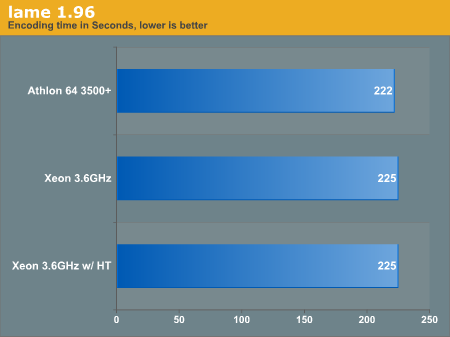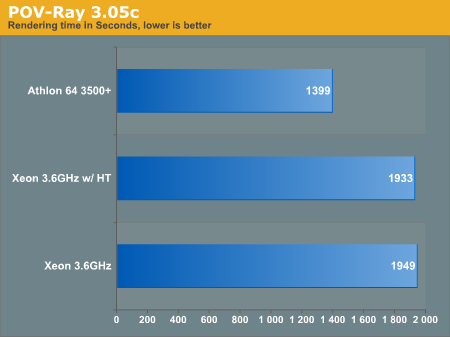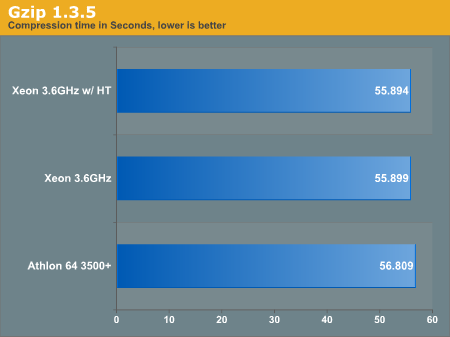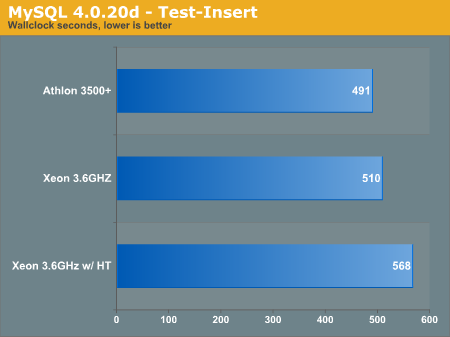Linux and EM64T; Intel's 64-bit Suggestion
by Kristopher Kubicki on August 9, 2004 12:05 AM EST- Posted in
- Linux
Audio Encoding
Lame was compiled from source without optimizations. We only ran ./configure and make, without any flags. We realize that some people would like to verify our binaries and sample files for their own benchmarks. In order to save bandwidth and prevent copyright infractions, we will provide our test files and binaries under limited circumstances to serious inquiries. We ran lame on a 700MB .wav file using the command equivalent to the one below:# lame sample.wav -b 192 -m s -h >/dev/null
Encoding time, lower is better.

POV-RAY
Although POV-RAY is limited in application (particularly when compared against Mental Ray), it does provide a free open source solution for basic rendering. POV-Ray 3.50c was our choice of render engine for this benchmark. For benchmark specifics, we run the exact benchmark as specified by the POV-Ray official site. We use the precompiled RPM for this test.Render Time in Seconds, less is better.

POV-Ray does not have multithread support, so we were not surprised to see the HyperThreading configuration slowing down to the configuration without HT. We see the Athlon 64 processor pull way ahead; render tasks are extremely CPU and memory dependant. With the memory controller on the CPU, Athlon 64 becomes the stronger offering in this situation.
GZip
To throw in some rudimentary tests for GZip, we used the included GZip 1.3.5 to compress the .wav file from the benchmark above. We do not want to limit our I/O on writing to the hard drive, so the operation is performed as below:# time gzip -c sample.wav > /dev/null

Intel wins their first bout of the analysis, albeit not by much. We will find a recurring pattern later on with integer based calculations and the Nocona Xeon processor. The entire Prescott family of Intel CPUs received a dedicated integer multiplier rather than continually using the floating point multiplier. This becomes extremely useful in some of our other benchmarks.
Database Performance
We will run the standard SQL-bench suite included with RPM MySQL 4.0.20d.

Of all our benchmarks, the SQL-bench becomes the most baffling. The extremely threaded database application performs particularly poorly with HyperThreading enabled. The Althon 64 outperforms Intel again in this benchmark, and a lot of it is almost certainly accredited to the on die memory controller again.
Update: We copied the 32-bit marks from our benchmark in previous testing instead of the 64-bit. You can view the previous articles here from a month ago. The graphs have also been updated.










275 Comments
View All Comments
Denial - Monday, August 9, 2004 - link
Doesn't Anand usually author the CPU articles himself? You'd think he would have definitely written this article since it represents such a major change in CPU's. I get the feeling he didn't want his name associated with the article or the chip.TechnoBabble - Monday, August 9, 2004 - link
I can't even believe someone did a review of a Xeon processor and a 64-Bit Athlon. Did the "author" even realize that the cache on the AMD was HALF of the cache on the Intel? Did he even DO any research on these two chips? I mean c'mon...let's rate apples to apples here. Or are the rmors correct and is this guy just a fan-boy or a payola-recipient of Intel??Hey, I have an idea...why don't you do the next "review" between a P4 EE and a Sempron? That would make for some GREAT reading just like this review did!!
Lucky this isn't a paysite because there could be a mass-exodus because of this crap-tacular article.
GEEZ...maybe Tom ISN'T that bad...
JGunther - Monday, August 9, 2004 - link
Such bad press all over tech websites... primer or no, if I were someone over there at AnandTech, I'd rip this thing down before it does any more damage to the site's reputation.opposable - Monday, August 9, 2004 - link
AnandTech has a right to compare any processor they wish. I don't care if they compared the Celeron to the Opteron, so long as the benchmarks and review were articulate and accurate. The cloudiness over what 'bit' some of the benchmarks were run at, the discrepancy between the benchmarks in the article and benchmarks from other sources (including AnandTech itself), and the errors and omissions are what really struck me about this article.I don't care if this was a 'primer,' it was poorly articulated, inadequate, and in some places potentially wrong. I certainly hope that this is not a trend, for AnandTech's sake.
JGunther - Monday, August 9, 2004 - link
An actual 3.6GHz Pentium4 (still a heck of a lost more costly than a 3500+) is compared at Ace's Hardware to some of AMD's offerings. Check it out here:http://www.aceshardware.com/read.jsp?id=65000316
It's not a 3.6F, but from what we've heard, 64bits shouldn't much affect 32bit performance.
Sorry if this has been posted before.
liquidrage2000 - Monday, August 9, 2004 - link
What I don't like about the review is that while the everyday visitor to the site is technical, these reviews show up in searches by people that are not technical.The two CPU's are not geared for the same market, and they aren't priced in the same ballpark.
Hell, the blurb on /. basically just said in a nutshell that Intel thrashed AMD.
So ignoring all the errors and problems with numbers, reviews like this shouldn't be published in this manner unless it's very clear that you're comparing apples to oranges. And it's not clear. Something like "Intel's Server line vs AMD's lowend new desktop" would be better. But overall, you just shouldn't have done this review. It's misleading.
RyanVM - Monday, August 9, 2004 - link
"Relax, its just a primer for future articles. A 3.6F is supposed to compare with a "3600+" rated Athlon 64 isnt it?"Be sure to let me know where I can buy a 3.6F for $350.
JGunther - Monday, August 9, 2004 - link
Viditor: Then why make it? Surely the FX-53 would have made for a better, if still not entirely fair (desktop vs. server) comparison.JGunther - Monday, August 9, 2004 - link
Hrm... just punched in the numbers, and the Intel CPU here is a laughable 240% more expensive than the AMD unit. Let's see the next part of this review: The AMD Opteron 250 vs. the P4 3.4GHz Northwood. Same price ratio.Haha better yet, let's see the A64 3500+ against the P4 2.6GHz w/ 533FSB. Again, 240% price difference.
Viditor - Monday, August 9, 2004 - link
"How, by any stretch of the imagination, is this a good comparison"Kris actually acknowledged that it wasn't in the review...
His point was to try and predict what the P4f will be like when it is finally released.
The only real problems with the review if looked at in that light are:
1. Many of the results appear to be in error
2. Only 1 gig of ram was used on a 64-bit system
3. He mixed 32 bit and 64 bit apps without being completely clear on it
4. He didn't publish memory timings
It has been speculated that he made errors with his makefile, and that he didn't compile for AMD when he tested the A64...